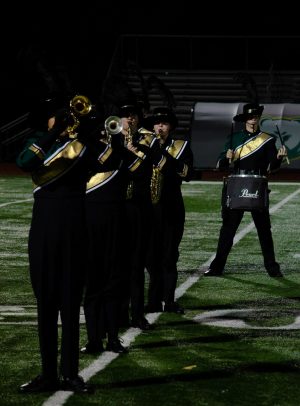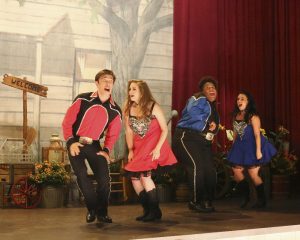Tales of trick-or-treating
In October, members of The ROCK staff reflected on the importance and impact of Halloween on their lives.
Whether it’s nostalgia-tinged wistfulness for the passed years of trick-or-treating and neighborly community or the unique dilemma that sharing a birthday with the frightening holiday poses or a reprimand to teens infringing their candy-grabbing hands on the holiday, the annual spooky night is filled-to-bursting with stories and memories.

You knew Halloween was coming when the soft underbelly of autumn’s air developed a bite, when you stepped outside and everything smelled vaguely of smoked maple syrup and the plumes of burgundy and gold leaves had given way to some shriveled brand of brown. The overzealous neighbors would’ve strewn their houses with Halloween lights and their yards with massive, inflatable ghosts and Frankensteins; the stores would be teeming with parents and giddy children, finally there for the Spiderman costumes and candy corn that had been put up about two months too early.
And then came the planning of the costumes. Like most children, there were the years where my parents stuffed me, reluctant, into princess costumes against my will, and all the pictures featured my sugar-high grimace. But after that I bullied them into letting my Halloween costumes function as a personal creative outlet, which meant costumes primarily centered around cats and Harry Potter and Mulan, the best princess of all.
The build-up was almost better than the actual thing.
Almost.
In the end, nothing could beat the day itself. Hearing the last bell of the school day and fully understanding what lay in store for that night. Or finally, finally, getting to put on the Best Costume Ever. Or the unique thrill of trick-or-treating, enhanced by its exclusivity to one spooky night a year.
More and more, though, the trick-or-treating is fading. Whether parents are concerned about their children’s safety or whether they just aren’t overly friendly with their neighbors or whether they prefer to have a nice party in the warmth, the number of children trick-or-treating on our streets is on the decline, and that is tragic.
Trick-or-treating is arguably the best part of Halloween. There’s an excitement in trying to predict which house will give you that lame apple, which house will leave the basket of candy out front with a “Please take one!” note to tease itching hands and sweet tooths or which house will be more invested in frightening trick-or-treaters than wholly necessary.
There’s something irreplaceable about shouting “Trick or treat!” too loudly at the slightly alarmed neighbors, about the backhand candy deals made while scurrying from house to house – 10 Tootsie Rolls for a Twix, an arm and a leg and most of your soul for some Swedish Fish.
But more than anything, trick-or-treating builds community and relationships. Even if it’s just that one night a year, something about the trick-or-treating bond lasts. The decline of trick-or-treating is reflective of a greater trend in our society: the decline of community; no one gets to know their neighbors anymore.
My neighborhood when I was growing up was like something out of a ‘90s TV show. It was fairly small with wide roads framed by grand trees and adorable houses. Everyone knew each other, would walk over to the next house to borrow sugar, would routinely have shouted conversations with people across the street while gardening and would give each other cats and trampolines.
The best part, though, was the group of kids. Regardless of how old we were, the kids on the block would hang out, come bright winter morning or sedated summer noon, playing Ghosts in the Graveyard or flipping on the trampoline or setting up elaborate basketball tournaments. We would build secret hideouts and invent recipes and talk. I grew up with these kids and their families; I grew up learning to be open and friendly and generous, to care about other people and their stories, to appreciate community and relationships, and its value has been immeasurable.
Maybe lamenting the decline of trick-or-treating seems trivial, the angsty pet project of a nostalgic teenager, but it’s about more than a fun childhood activity; it’s about community, about people and their stories. Building community engenders healthy and happy societies and healthy and happy people; studies have even proven it to reduce crime.
I moved to a new house this summer, the only other one I’ve lived in in my entire life, and it’s not the same. Coming from an old, close-knit neighborhood to a new and sparse one is a transition that’s hard to swallow. Nobody comes over to chat about Thanksgiving plans or drop off zucchini bread on a whim. We haven’t bonded over scooter races down the hill. Our neighbors haven’t met my cat, Butterbeer, the best cat in the world, and we haven’t met whatever pets they naively claim to be the best in their world. We’ve met our neighbors, but we haven’t really met them at all. The ever-important sense of community is gone, and I’m left imagining stories to fill the enigma that lingers in the houses and the people around us.
By Urmila Kutikkad
[heading size=”18″]Combination of Halloween, birthday creates tradition during childhood[/heading]
Halloween is not a normal holiday. It has no acknowledged religious affiliation, such as most holidays, and it has no American historical or governmental significance, being one of the few widely observed holidays that doesn’t fall into either category, like Valentine’s Day or St. Patrick’s Day. Despite the lack of tremendous influence on peoples’ lives, Halloween is the second most celebrated holiday in America today.
Birthdays, however, aren’t even holidays really, just something celebrated once a year by close friends and relatives. Although not a communal holiday, birthdays are most likely one of the most celebrated days of the year for a person.
Having a birthday on Oct. 31 made this date very different for me than most people; I can’t associate one holiday in my head without the other. I always received candy and presents on the same day. I dressed up in a costume on my birthday as a young child and my birthday cakes often displayed black and orange decor.
Because the prominent source of cultural infusion in my life came from my father, I am an ardent traditionalist. I am an avid fan of Notre Dame football, I rarely enjoy music from this century, and I prefer classic books and movies. This traditionalism has had a major impact on my life, including the fact that I have spent many of my birthdays consuming candy while watching some of my favorite quintessential Halloween and thriller movies, such as “Halloween” and “Psycho.”
While many people have either told me that I’m lucky or unlucky to having this shared holiday, there are no definitive emotions that I have for having my birthday on the same date as Halloween. There were benefits and drawbacks. My neighbors who knew it was my birthday usually gave me double amounts of candy; however, I don’t remember having many birthday parties throughout my life, probably because a young child could never schedule a party on Halloween.
Now that it has been 16 years of having Halloween and my birthday on the same day, there’s no life altering change that comes with having a birthday on a holiday. It doesn’t dramatically alter me as a person, but I would like to think that it fed to my personal development as a young child, when views can be most skewed. Just like everyone else in the world, I have self-confidence issues, self-esteem issues and all that go along with those. Being born into a family where achievement and excellence are highly prioritized, I believe it was important to the psyche of my much younger self that my birthday meant something to other people, people who didn’t know me at all, as there are fewer opportunities for achievement the younger a child is.
Just as things were added to and subtracted from each aspect of the duality of Oct. 31, I missed out on some key parts of birthdays and Halloween such as the birthday parties I lacked as a young child. I stopped trick-or-treating younger than most of my friends; I had outgrown it and wanted to spend more of my day celebrating my birthday.
My birthday may have ruined Halloween for me; however, when I sit down to watch those movies that remind me of how much I enjoy the holiday, I still look back on it fondly as a part of my childhood. I don’t regret this because most people abandon Halloween as an essential holiday at some point and because I have already done so, it has allowed me to celebrate my birthday like I never have before.
While I didn’t exactly need the help, having my birthday on Halloween most importantly established a day filled with great traditions for me once a year. Tradition can be vital, a bright spot in dark times. It can be a routine in a hectic and crazed schedule filled with stress. Everyone and every place create their own traditions because people want to look for the few things in their life that never change, the few things that they can always count on to be the same.
By Luke Chval
[heading size=”18″]Older trick-or-treaters ruin holiday for younger children[/heading]
Sometimes high school students confuse me. Why would someone still go trick-or-treating at 16? Trick-or-treating is for little kids; teenagers should be the ones handing out the candy. It’s really awkward, handing out your candy to kids your age, when you can see a group of children walking down the street towards your house and you are running out of candy.
Two years ago, I was giving out candy to children as I do every year when at 9 p.m. I answered the door for a group of junior high and high school students. Imagine my surprise as I handed the last of my candy to these teenagers, thinking there wouldn’t be any more trick-or-treaters that night. I was wrong.
Half an hour later, the doorbell rang again. I looked outside and saw a small group of children with their parents standing nearby. Surprised, I scrambled to find some candy as my mom answered the door. I tore through my cupboard in my search, eventually scrounging together just enough to give each kid a few pieces each.
Afterwards I felt terrible. Not having enough candy to give to children on Halloween is really embarrassing, and got me thinking, why do teenagers go trick-or-treating? Isn’t that for the kids, with the adults and teens staying home and distributing the treats? Shouldn’t teenagers at least be at Halloween parties rather than going door to door for candy?
This moment transported me back to my childhood, when I spent my Halloween walking down cold, dark streets to receive candy from strangers. I reminisced about dressing up in cheesy outfits that I never used again, and bringing buckets of candy back home. I remembered when I ended up in a group of about five kids with our parents, walking through many different neighborhoods when a group of teenagers turned the corner in front of us. As they walked away, my group entered the neighborhood they had just exited. Many of the houses did not have any candy left, and most of them had only a little left. I thought nothing of it at the time, but that night two years ago made me think if it was those teenagers’ fault that my group didn’t get much candy from that neighborhood.
Last year, I made sure I bought enough candy to give to everyone, ending up with a surplus of sweets. I was glad that not as many teenagers came to my door. Most of them were just escorting their younger siblings, which I applaud. Others, however, were still going around getting candy. Before the night began, I thought about what I was going to do about the teenagers that would inevitably still be trick-or-treating. Would I answer the door for them? Would I turn them away? After much contemplation, I still gave them candy although I gave them less than what I gave the younger kids.
Despite my discrimination, I do understand part of the reasoning behind trick-or -treating at this age. Everybody likes sugar and sweets, and everyone likes free stuff. Halloween has both of these things at every few feet. Each house is pretty much a convenience store giving out candy for free. However, at the age high schoolers are at, most of them can drive to a store themselves and have jobs that will refill their pockets after they spend a few dollars for a large bag of candy or two.
Maybe high school students are finally maturing, or maybe they are just getting busier. Whatever the reason, there was a decline of teenagers trick-or-treating in my neighborhood. This is a good sign for children and adults alike. People will give more candy to kids, and families will not have to spend as much money to satisfy the needs of the trick-or-treating community. Maybe our high school population will finally start acting its age.
By Derek Wang
















































































